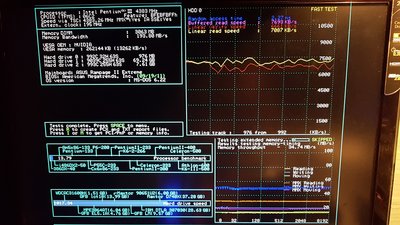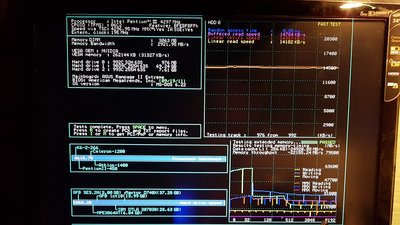Despite having the External Cache Enable/Disable option in BIOS there isn't any motherboard/L2 cache... I don't think there are any when it comes to Slot 1s? There are 6 variables in terms of switches (including none).. they are, in order of fastest to slowest...
1) Nothing/All Enabled
2) BPD
3) ICD
4) ICD+BPD
5) L1D
6) L1D+BPD
Adding ICD to 5 or 6 yields no changes. Still, with 6 settings, 8 FSB speeds and 16 multipliers it's a little over 700 combinations -- it's going to take a while.
I see the main goal of this thread and spreadsheet as getting accurate 'performs like' settings of our different builds with caching and down-clocking tricks. We can see SpeedSys ratings are useless by themselves when trying to match another system -- Clueless sorts the benchmarks by Doom FPS for a reason... but I don't think it is totally random, either. Also, Doom seems to be pretty weird about what it likes and what it doesn't -- I get better Doom FPS on my K6-III+ 550mhz then I do on my 2.4ghz Athlon 64 4000+, for instance.
FSB plays a big part in the differences and the real legacy systems are using 33FSB or less, after all. In the build I mentioned at the start there are several ways to achieve the same clock speed.
I haven't done any Doom bench-marking yet but take 600mhz for example and look at the differences in results -- all on the same CPU.
@600mhz (133 x 4.5)
SpeedSys: 315.45
PCPBench: 80.4
3DBench2: 320.8 […]
Show full quote
@600mhz (133 x 4.5)
SpeedSys: 315.45
PCPBench: 80.4
3DBench2: 320.8
@600mhz (100 x 6)
SpeedSys: 314.38
PCPBench: 70.1
3DBench2: 275.2 […]
Show full quote
@600mhz (100 x 6)
SpeedSys: 314.38
PCPBench: 70.1
3DBench2: 275.2
@600mhz (75x8)
SpeedSys: 314.37
PCPBench: 60.9
3DBench2: 236.6 […]
Show full quote
@600mhz (75x8)
SpeedSys: 314.37
PCPBench: 60.9
3DBench2: 236.6
@600mhz (66 x 9)
SpeedSys: 315.11
PCPBench: 55.4
3DBench2: 215.1 […]
Show full quote
@600mhz (66 x 9)
SpeedSys: 315.11
PCPBench: 55.4
3DBench2: 215.1
@600mhz (50x12)
SpeedSys:313.56
PCPBench: 45.6
3DBench2: 175.1 […]
Show full quote
@600mhz (50x12)
SpeedSys:313.56
PCPBench: 45.6
3DBench2: 175.1
Notice that even as the PCP and 3D2 scores almost half from the top marks to the bottom that the SpeedSys ratings float right around the same area. The closest benchmark to this SpeedSys on our tables is
Clueless' Pentium II 266 (66x4)
SpeedSys: 309.88
PCPBench: 77.3
3DBench2: 195.0 […]
Show full quote
Clueless' Pentium II 266 (66x4)
SpeedSys: 309.88
PCPBench: 77.3
3DBench2: 195.0
Compared to my 66FSB setting that yields a slightly faster SpeedSys the Pentium II has ~-20FPS in 3D2 and ~+20 in PCP. I don't use FASTVID or MTRRLFBE though in any of my benchmarks. It can be hard to get a good comparison when that isn't a constant throughout other benchmarks.
Here's another comparison --
Clueless' K6-2 @ 366 (66x5.5)
SpeedSys: 419.60
PCPBench: 79.8
3DBench2: 246.7 […]
Show full quote
Clueless' K6-2 @ 366 (66x5.5)
SpeedSys: 419.60
PCPBench: 79.8
3DBench2: 246.7
My 800mhz benchmarks all match this SpeedSys rating closest, at ~420. Here are those VGA results:
(133x6)
PCPBench: 93.6
3DBench2: 367.2 […]
Show full quote
(133x6)
PCPBench: 93.6
3DBench2: 367.2
(100x8)
PCPBench: 79.5
3DBench2: 308.4
(66x12)
PCPBench: 61.1
3DBench2: 234.7
The 100FSB has a nearly identical PCP benchmark -- but the 3D2 score is much higher. Again, perhaps using MTRRLFBE would boost both the 66x12 scores up to be a very close match on both.
Please help and share if you find any patterns within the benchmarks we have so far and/or within your own!


